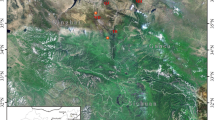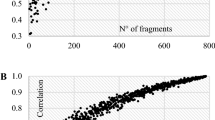Abstract
Dendrobium officinale is a critically endangered perennial herb endemic to China. Determining the levels of genetic diversity and patterns of population genetic structure of this species would assist in its conservation and management. Data of 12 populations were used to assess its genetic diversity and population structure, employing the method of amplified fragment length polymorphism (AFLP). A high level of genetic diversity was detected (H E = 0.269) with POPGENE. As revealed by AMOVA analysis, there was moderate variation between pairs of populations with ΦST values ranging from 0.047 to 0.578 and on average 26.97% of the genetic variation occurred among populations. Three main clusters were shown in UPGMA dendrogram using TFPGA, which is consistent with the result of principal coordinate ananlysis (PCO) using NTSYS. Keeping a stable environment is critical for the in situ conservation and management of this rare and endangered plant, and for ex situ conservation it is important to design an integrated germplasm bank.



Similar content being viewed by others
References
Bao XS, Shun QS, Ye YQ, Gu HF (1999) History and current status of Dendrobium medicinal “fengdou”. Chinese Traditional and Herbal Drugs 22:540–542
Bartareau T (1995) Pollination and breeding systems in varieties of Dendrobium canaliculatum and their implications on the taxonomic status of the group. Orchadian 11:381–387
Bechtel H, Cribb P, Launert E (1981) The manual of cultivated orchid species. Blandford Press, UK
Blears MJ, De Grandis SA, Lee H, Trevors JT (1998) Amplified Fragment Length Polymorphism (AFLP): a review of the procedure and its applications. J Ind Microbiol Biotechnol 21:99–114
Bonin A, Bellemain E, Bronken Eidesen P, Pompanon F, Brochmann C, Taberlet P (2004) How to track and assess genotyping errors in population genetic studies. Mol Ecol 13:3261–3273
Borba EL, Felix JM, Solferini VN, Semir J (2001) Fly-pollinated Pleurothallis (Orchidaceae) species have high genetic variability: evidence from isozyme markers. Am J Bot 88:419–428
Borba EL, Semir J (2001) Pollinator specificity and convergence in fly-pollinated Pleurothallis (Orchidaceae) species: a multiple population approach. Ann Bot 88:75–88
Bussell JD (1999) The distribution of random amplified polymorphic DNA (RAPD) diversity amongst populations of Isotoma petraea (Lobeliaceae). Mol Ecol 8:775–789
Chen QH (2004) Flora Guizhouensis, vol 10. Guizhou Science and Technology Publishing House, Guiyang
Chun Z (2005) Resource crisis of Dendrobium and its protective countermeasure. Resour Develop Mar 21:139–140
Dice LR (1945) Measures of the amount of ecologic association between species. Ecology 26:297–302
Ding XY, Xu LS, Wang ZT, Zhou KY, Xu H, Wang YQ (2002) Authentication of stems of Dendrobium officinale by rDNA ITS region sequence. Planta Med 68:191–192
Dressler RL (1993) Phylogeny and classification of the orchid family. Cambridge University Press, Cambridge
Eduardo LB, Joaa OS, George JS (2001) Self-incompatibility, inbreeding depression and crossing potential in five Brazilian Pleurothallis (Orchidaceae) Species. Ann Bot 88:89–99
Excoffier L, Smouse PE, Quattro JM (1992) Analysis of molecular variance inferred from metric distances among DNA haplotypes: application to human mitochondrial DNA restriction data. Genetics 131:479–491
Fu LK (1992) China plant red data book: rare and endangered plants, I. Science Press, Beijing, China
George CG, Joseph RJ (1979) Genetic distance and heterozygosity estimates in electrophoretic studies: effects of sample size. Copeia 2:242–249
Hamrick JL (1982) Plant population genetics and evolution. Am J Bot 69:1685–1693
Hamrick JL, Godt MJW (1990). Allozyme diversity in plant species. In: Brown AHD, Clegg MT, Kahler AL, Weir BS (eds) Plant population genetics, breeding, and genetic resources. Sunderland, Sinauer, pp. 43–63
Hamrick JL, Godt MJW (1996) Effects of life history traits on genetic diversity in plant species. Philosophical Transactions of the Royal Society of London. Series B, Biol Sci 351:1291–1298
IUCN/SSC Orchid Specialist Group (1996) Orchids: status survey and conservation action plan. IUCN, Gland Switzerland and Cambridge, UK
Johansen B (1990) Incompatibility in Dendrobium (Orchidaceae). Bot J Linn Soc 103:165–196
Juan A, Crespo MB, Cowan RS, Lexer C, Fay MF (2004) Patterns of variability and gene flow in Medicago citrina, an endangered endemic of islands in the western Mediterranean, as revealed by amplified fragment length polymorphism (AFLP). Mol Ecol 13:2679–2690
Kosman E, Leonard KJ (2005) Similarity coefficients for molecular markers in studies of genetic relationships between individuals for haploid, diploid, and polyploidy species. Mol Ecol 14:415–424
Lande R (1988) Genetics and demography in biological conservation. Science 241:1455–1460
Lewontin RC (1972) The apportionment of human diversity. Evol Biol 6:381–398
Li A, Ge S (2006) Genetic variation and conservation of Changnienia amoena, an endangered orchid endemic to China. Pl Syst Evol 258:251–260
Li A, Luo YB, Xiong ZT, Ge S (2002) A preliminary study on conservation of three endangered orchid species. Acta Bot Sin 44:250–252
Maunder M, Cowan RS, Stranc P, Fay MF (2001) The genetic status and conservation management of two cultivated bulb species extinct in the wild: Tecophilaea cyanocrocus (Chile) and Tulipa sprengeri (Turkey). Conserv Genet 2:193–201
Miller MP (1997) Tools for population genetic analysis (TFPGA) 1.3: A windows program for the analysis of allozyme and molecular population genetic data. Department of Biological Sciences, Northern Arizona University, Arizona, USA
Miller MP (1998) AMOVA-PREP. A program for the preparation of AMOVA input files from dominant-marker raw data, release 1.01. Department of Biological Sciences, Northern Arizona University, Arizona, USA
Nei M (1973) Analysis of gene diversity in subdivided populations. Proc Natl Acad Sci 70:3321–3323
Nei M (1978) Estimation of average heterozygosity and genetic distance from a small number of individuals. Genetics 89:583–590
Nybom H (2004) Comparison of different nuclear DNA markers for estimating intraspecific genetic diversity in plants. Mol Ecol 13:1143–1155
Pedersen HA (1995) Anthecological observations on Dendrochilum longibracteatum- a species pollinated by facultatively anthophilous insects. Lindleyana 10:19–28
Rohlf FJ (2000) NTSYS-pc: Numerical Taxonomy and Multivariate Analysis System, Version 2.1., New York, USA
Song JY, Guo SX (2001) Effects of fungus on the growth of Dendrobium candidum and D. nobil in vitro culture. Acta Academiae medicinae sinicae 6:547–551
Su H, Yang Y (2006) State quo of Dendrobium spp. resources of Nabanhe Nature Reserve and countermeasures for protection. Forest Invent Plan 31:100–102
Sun M, Wong KC (2001) Genetic structure of three orchid species with contrasting breeding systems using RAPD and allozyme markers. Am J Bot 88:2180–2188
Sun YY, Li K, Li CR, Duan ML, Su JK (2006) Current situation and development countermeasures of Dendrobium spp. industry for medicinal purpose of Yunnan province. Forest Invent Plan 31:45–47
The Pharmacopoeia Commission of PRC (Eds.) (2000) Pharmacopoeia of the People’s Republic of China. Chemical Industry Press, Beijing, China
Tsi ZH (1999) Flora of China. Science Press, Beijing
Vos P, Hogers R, Bleeker M, Reijans M, Lee TVD, Hornes M, Frijters A, Pot J, Peieman J, Kuiper M, Zabeau M (1995) AFLP: a new technique for DNA fingerprinting. Nucleic Acids Res 23:4407–4414
Wang JH, Zhang YX, Liu F, Huang CN, Ge JG (1996) Conservation of seeds, protocorms and protocorm-like-bodies of Dendrobium candidum. Acta Horticulturae Sinica 26:59–61
Winfield MO, Arnold GM, Cooper F, Leray M, White J, Karp A, Edwards KJ (1998) Study of genetic diversity in Populus nigra subsp. betulifolia in the upper Severn area in the UK using AFLP markers. Mol Ecol 7:3–10
Wong KC, Sun M (1999) Reproductive biology and conservation genetics of Goodyera procera (Orchidaceae). Am J Bot 86:1406–1413
Wright S (1951) The genetical structure of populations. Ann Eugenetics 15:323–354
Wu HF, Li ZZ, Huang HW (2006) Genetic differentiation among natural populations of Gastrodia elata (Orchidaceae) in Hubei and germplasm assessment of the cultivated populations. Biodivers Sci 14:315–326
Wu ZY (2003) Flora Yunnanica (Tomus 14). Science Press, Beijing
Xiao M, Li Q, Guo L, Luo T, Duan WX, He WX, Wang L, Chen F (2006) AFLP analysis of genetic diversity of the endangered species Sinopodiphyllum hexandrum in the Tibetan region of Sichuan province. China Biochem Genet 44:47–60
Yeh FC, Yang RC, Boyle T (1999) POPGENE. Microsoft windows-based freeware for population genetic analysis. Release 1.31. University of Alberta, Edmonton
Zhang CF, Zhang SY (1993) Flora of Zhejiang (Tomus 7). Zhejiang Science and Technology Publishing House, Hangzhou
Zhang M, Xia HX, Zhu LQ, Zhang YJ (2000) Research progress of Dendrobium tissue culture. China J Chinese Materia Medic 6:323–326
Acknowledgment
We would like to thank the National Natural Science Foundation of China for financial support (NO.30370144).
Author information
Authors and Affiliations
Corresponding author
Electronic supplementary material
Below is the link to the electronic supplementary material.
Rights and permissions
About this article
Cite this article
Li, X., Ding, X., Chu, B. et al. Genetic diversity analysis and conservation of the endangered Chinese endemic herb Dendrobium officinale Kimura et Migo (Orchidaceae) based on AFLP. Genetica 133, 159–166 (2008). https://doi.org/10.1007/s10709-007-9196-8
Received:
Accepted:
Published:
Issue Date:
DOI: https://doi.org/10.1007/s10709-007-9196-8




